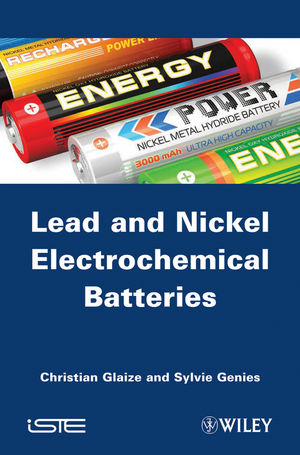
Lead-Nickel Electrochemical Batteries
ISTE Ltd and John Wiley & Sons Inc (Verlag)
978-1-84821-376-0 (ISBN)
- Titel z.Zt. nicht lieferbar
- Versandkostenfrei innerhalb Deutschlands
- Auch auf Rechnung
- Verfügbarkeit in der Filiale vor Ort prüfen
- Artikel merken
This book will show that batteries are complex systems, made commercially available thanks to considerable amounts of scientific research, empiricism and practical knowledge. However, the design of batteries is not fixed; it is subject to constant developments as a result of user feedback and validation processes which are often long and fastidious. This book attempts to show that it is not possible to consider a family of batteries as having fixed, applicable properties and characteristics whatever the application and the technology used in their manufacture. For this reason, the authors have chosen to present the fundamental electrochemical and chemical phenomena involved in as simple and as clear a way as possible. It is essential to be aware of these mechanisms in order to develop suitable theoretical models.
This work will be of particular interest to those working in the field of electrical engineering and to industrialists, the final users of these technologies. It will also be of interest to electrochemists, as experts in lead or nickel batteries are becoming fewer and farther between, and their knowledge and practical skills are steadily being lost.
Contents
Part 1. Universal Characteristics of Batteries
1. Definitions and Methods of Measurement.
Part 2. Lead–Acid Batteries
2. The Operation of Lead–Acid Batteries.
3. Internal Composition and Types of Lead–Acid Batteries.
4. Lead Batteries: Main Characteristics.
5. Manufacturing Starting, Lighting and Ignition Batteries.
Part 3. Introduction to Nickel-Based Batteries
6. Nickel–Cadmium Batteries.
7. Nickel–Metal Hydride Batteries.
8. Other Nickel-Based Batteries.
Christian Glaize is Professor at University of Montpellier, France. Sylvie Genies is Project manager at Alternative Energies and Atomic Energy Commission and internal expert for lead-acid technology, Grenoble, France.
Preface xv
Acknowledgments xvii
Introduction xix
PART 1. UNIVERSAL CHARACTERISTICS OF BATTERIES 1
Chapter 1. Definitions and Methods of Measurement 3
1.1. Introduction 3
1.2. Terminology 3
1.3. Definitions of characteristics 7
1.4. Battery states 20
1.5. Faradic efficiency 32
1.6. Charge coefficient 34
1.7. Overcharge coefficient 34
1.8. Energy efficiency 34
1.9. Self-discharge 36
1.10. Acceptance current 37
1.11. Conclusion 37
1.12. Appendix: Nernst’s law 38
1.13. Solutions to exercises 48
PART 2. Lead–ACID BATTERIES 55
Chapter 2. The Operation of Lead–Acid Batteries 59
2.1. Principles of operation 59
2.2. Properties due to electrochemical reactions 80
2.3. Polarity inversion 96
2.4. Effects of temperature, aging and thermal runaway 97
2.5. Failure modes 100
2.6. Appendices 107
2.7. Solutions to exercises 110
Chapter 3. Internal Composition and Types of Lead–Acid Batteries 115
3.1. Composition of lead–acid batteries 115
3.2. Families of lead–acid batteries 126
3.3. Other battery types and future prospects 132
Chapter 4. Lead Batteries: Main Characteristics 135
4.1. Introduction 135
4.2. Electrical characteristics 135
4.3. Charge of lead batteries 149
4.4. Energy management 155
4.5. SOC indicator 156
4.6. Conditions of use 162
4.7. Economic considerations 171
4.8. Applicable standards 174
4.9. Future developments 175
4.10. To find out more 176
4.11. Solutions to exercises 176
Chapter 5. Manufacturing Starting, Lighting and Ignition Batteries 181
5.1. Introduction 181
5.2. Manufacturing an SLI battery 182
5.3. Raw materials 184
5.4. Different ways of manufacturing lead SLI batteries 189
5.5. Composition of the paste 201
5.6. Pasting the grids 204
5.7. Curing of the plates 204
5.8. Assembly 209
5.9. Formation of the battery 218
5.10. Final test and dispatch 225
5.11. Solutions to exercises 225
PART 3. INTRODUCTION TO NICKEL-BASED BATTERIES 227
Chapter 6. Nickel–Cadmium Batteries 229
6.1. Introduction 229
6.2. Operating principle 230
6.3. Main characteristics 236
Chapter 7. Nickel–Metal Hydride Batteries 251
7.1. Introduction 251
7.2. Operating principle 252
7.3. Main characteristics 256
7.4. Solution to exercise 271
Chapter 8. Other Nickel-Based Batteries 273
8.1. Introduction 273
8.2. Nickel–iron batteries 273
8.3. Nickel–zinc batteries 277
8.4. More information on nickel-based batteries 286
8.4.1. Resources and properties of nickel 286
8.4.2. Recycling channels for nickel-based batteries 286
8.4.3. Bibliography 287
Conclusion 289
Index 291
| Verlagsort | London |
|---|---|
| Sprache | englisch |
| Maße | 163 x 241 mm |
| Gewicht | 590 g |
| Themenwelt | Naturwissenschaften ► Chemie ► Physikalische Chemie |
| Technik ► Elektrotechnik / Energietechnik | |
| ISBN-10 | 1-84821-376-X / 184821376X |
| ISBN-13 | 978-1-84821-376-0 / 9781848213760 |
| Zustand | Neuware |
| Haben Sie eine Frage zum Produkt? |
aus dem Bereich


